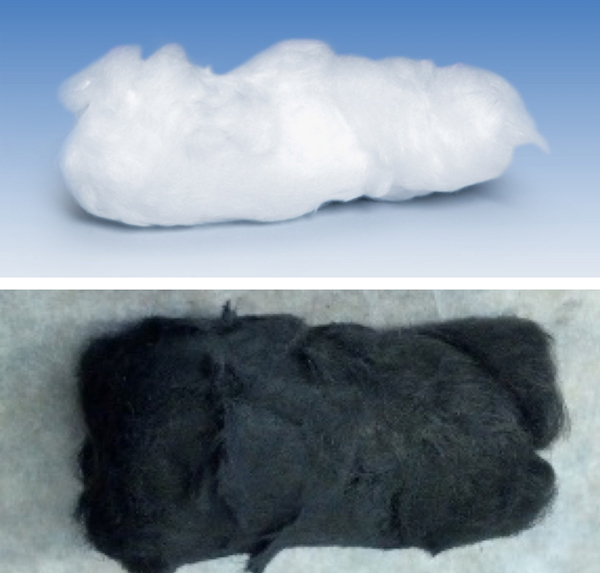
[Image above] Plain quartz fiber, top, gains the ability to remove toxic metals from water when carbon nanotubes are added, bottom. The filters absorbed more than 99 percent of metals from test samples laden with cadmium, cobalt, copper, mercury, nickel and lead. Once saturated, the filters can be washed and reused. Credit: Barron Research Group/Rice University
Water is essential for all living things. It’s a resource that we in developed countries take for granted. Scientists are continuing to make progress in water purification and filtration, processes, but we still have a ways to go to get clean water to everyone on the planet.
And we still have some work to do in the U.S. to clean up our water. The EPA sets standards for maximum limits of specific contaminants in water. But when contaminants like heavy metals get into the bloodstream, the damage is already done. The Flint, Michigan water crisis, and the Duke Energy coal ash spill remind us that some contaminated water—especially water containing heavy metal—can kill us.
Heavy metals—the elements, not the music genre—are a category of metals that can be toxic to humans after long term accumulation in the body. When absorbed into the body, they can damage organs and tissues, causing a lifetime of chronic health issues—and in some cases, can lead to death. They typically appear in water in communities that have no public purification or filtration system. They also can leach into the groundwater via landfills when we improperly toss our electronics into the trash instead of recycling them.
Fortunately, researchers at Rice University might have come up with a solution to keep those dangerous metals out of the water. Andrew Barron, Rice chemist and Perry Alagappan, an undergrad student at Stanford University, along with a research team, have created a reusable filter—a “supported epoxidized carbon nanotube,” or SENT—that can absorb nearly all heavy metals from water.
The key to the filter’s ability to remove toxic metals from water is in the carbon nanotubes that the team added to quartz fiber material. After an epoxidation process, they filtered five liters of water within a minute. In addition, “The material retained nearly 100 percent of its capacity to filter water for up to 70 liters per 100 grams of SENT, after which the metals contained could be extracted for reuse or turned into a solid for safe disposal,” according to Rice University’s news release.

An electron microscope image shows quartz fibers with carbon nanotubes grown in place. Credit: Barron Research Group/Rice University
The filters can be reused by simply cleaning them in vinegar, a product that “every culture on the planet knows how to make,” Barron explains in the release. He also says that the filter materials are inexpensive—making the filters affordable for third world countries to produce.
Alagappan had previously earned several awards for his research, including the 2015 Stockholm Junior Water Prize, while he was still in high school. “The first time I really got to learn about water purification and the challenges, was when I went to India—and there I saw the problems of heavy metal contamination,” he recalls in a video. “Those are metals that come into the environment from a variety of sources, primarily electronics—when we dispose of computers, technology, and batteries. All those metals get into water supplies.”
Alagappan would like to eventually see the technology scaled for wider use.
“This would make the biggest social impact on village-scale units that could treat water in remote, developing regions,” Barron says in the release. “However, there is also the potential to scale up metal extraction, in particular from mine wastewater.”
The paper, published in Scientific Reports is “Easily Regenerated Readily Deployable Absorbent for Heavy Metal Removal from Contaminated Water” (DOI: 10.1038/s41598-017-06734-7).
Author
Faye Oney
CTT Categories
- Basic Science
- Environment
- Material Innovations
- Nanomaterials


